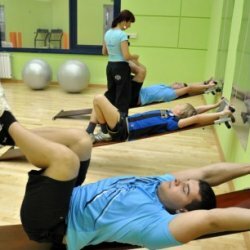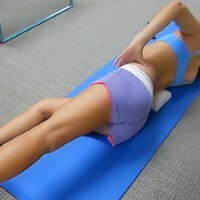Restoration of the spine in the gym
 Restore the spine after injuries, injuries or some diseases can be done with special exercises. Some exercises can be performed at home, and some in the gym. There are many sets of exercises that have a preventive effect on the spine and prevent the appearance of diseases and injuries.
Restore the spine after injuries, injuries or some diseases can be done with special exercises. Some exercises can be performed at home, and some in the gym. There are many sets of exercises that have a preventive effect on the spine and prevent the appearance of diseases and injuries.
However, before you go to the gym and start practicing, you need to remember that the recovery process should be gradual, as severe physical exertion can only worsen your condition. At the first stage it is impossible to give strong loads on the spine and back. As the overall well-being and spine state improve, physicians are allowed to gradually increase the load. Individually selected exercises on the simulators will allow you to recover much faster.
Stages of Physical Rehabilitation
There are several stages of physical rehabilitation. Below we will consider each of them:
1. The stage of subcompensation. At this stage, the main goal is to start the processes of reconstructing the compensatory structures for the damaged segments of the musculoskeletal system. Such compensatory structures partially take on the functions that the damaged parts of the joints, spine and limbs can not perform.
Subcompensation is assigned to those people who have recently been in the hospital or those who suffer from back pain. For a month, such people undergo a rehabilitation course using special programs. The basic means of such programs are physical exercises that are performed without exercisers, exercises for relaxation and breathing exercises. In the complex, such exercises contribute to neuroendocrine regulation, restoration of nutrition and unloading of affected structures of the spine. Other means are also used, for example, sauna therapy.
At home, the patient can do himself. To do this, he must be guided by didactic materials. As the long experience of doctors shows, an integrated approach to solving this problem helps to achieve significant improvements in a short time.
At the first stage, the patients have a reduced level of pain, a feeling of self-confidence and a loss of fear. After the completion of the course of physical rehabilitation, patients are transferred to the second group - a group of unsustainable compensation. This group is called so because the compensation mechanisms are not yet fully formed and they are unstable, so relapses of the pain syndrome may appear.
2. Stage of unstable compensation. The duration of this stage for each person is determined individually. On average, the stage can last from two to three months to six months. Rehabilitation at this stage consists of two parts. The first part is classes in the gym, but here the exercises are much more complicated than at the previous stage. Such exercises are aimed at improving the entire body. Therefore, they are aimed not only at forming compensatory structures, but also at improving the activity of the cardiovascular system, the reproductive sphere, the central nervous system and internal organs.
At this stage, the main emphasis is on the formation of the necessary muscle mass of the body. In the second part, the problem of optimizing the muscle mass of the body is solved. Patients are already engaged in the gym. As a rule, already at this stage the pain sensations in the extremities and back disappear, the working capacity is fully restored and the quality of life is normalized.
3. Stage of sustainable compensation. The duration of this phase is from two to three months. At this stage, the patient is already fully formed structures, which later assume the functions of damaged structures of the spine. The patient feels well and only occasionally there are pain.
Most often, because of the improvement in health, people lose their caution and begin to behave as if their spine is completely healthy. They can stop regular activities, overload themselves with physical exertion and the like. In such cases, relapse often occurs.
Training for rehabilitation of the spine
Training in the gym allows you not only to lose weight, gain muscle mass, they also help improve the condition of the ligaments and muscles of the spine. A good musculature of the back removes unnecessary strain from the spine and slows the aging process of the whole organism, blood circulation also normalizes, which facilitates the rapid restoration of intervertebral discs.
Rules for training
- to engage in fitness can only after acute pain in the back pass;
- if during exercise you feel discomfort, then for a while you should give them up or reduce weight;
- for efficiency is worth doing two or three times a week;
- training should include a warm-up and a major part;
- should not be too heavily loaded, it's necessary to conduct training at an average pace;
- pauses between approaches should be 5 minutes, you can also focus on your breathing;
- during training it is absolutely necessary to use a special back corset or a belt for a weightlifter.
What can not be done with problems with the back :
- can not work with a lot of weight, this applies to all exercises for any muscle groups;
- it is impossible to carry out such exercises: squats with a bar, twisting of a trunk with a load on shoulders;
- can not be strongly bent back during exercises with dumbbells or without them;
- should avoid exercises that heavily load the spine( bench press and the like).
Strength exercises for osteochondrosis
Osteochondrosis is a serious disease. The main part of training with this disease is aimed at removing discomfort and pain syndrome. The pains arise from the fact that disks are shifting, which begin to squeeze the nearby motor nerves. Thus, pain occurs not only in the spine, but also in the limbs.
The best fixation for the vertebrae is deep back muscles, they surround the spinal column. Thus, in the case of osteochondrosis with the help of training, deep muscles of the back should be strengthened with the help of exercises with weights. In addition, weight training contributes to the retention of calcium in the bones, which prevents further destruction of the disc.
During training it is necessary to adhere to such principles :
- Special attention should be given to the back. In training, you need to include exercises: slopes with a stick behind the head, hyperextension, slopes in the side with a dumbbell in the hand, pull-ups, lunges with dumbbells, traction from the top block by the head to the chest.
- After each workout, be sure to stretch the spine: hang on the crossbar with a completely relaxed back.
- In the first few months, completely eliminate the axial load on the spine.
- Eliminate excessive deflection in the back.
- Do not just rest your back, train the whole body.
- After three months in training you can include such exercises: deadlift, squats and slopes with dumbbells.



